Principle: Produce no waste
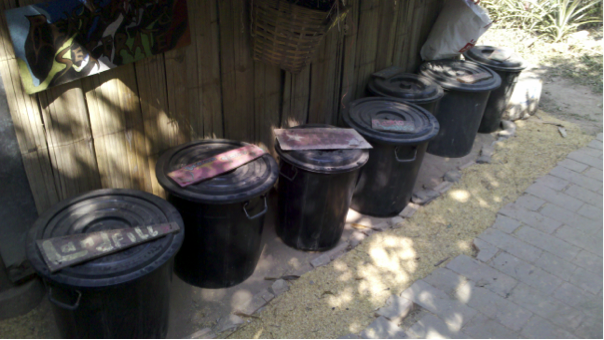
Waste, by definition, is material that is not wanted. Sanitation refers to conditions related to waste, especially as it relates to sewage and commercial waste disposal. As a human culture, we typically regard feces as waste and we throw too many things away. As a result, we waste a tremendous amount of water, our landfills are bursting and there is a toilet bowl of garbage in the ocean. As a culture, we have a problem with sanitation.
There are generally two types of waste important to a permaculture site – poop and trash. In this chapter, we will identify common types of waste and see how we can make use of them before they become “waste”.
Commercial byproducts
Commercial waste includes things we buy, which eventually become something we can’t use. Common waste materials around communities include aluminum cans, glass bottles, plastic bottles, palettes, cardboard, newspaper/paper, food scraps, plastic bottles, metal scraps, plastic wrappers, glossy magazines, plastic bags and packaging.
Ways to cut down on waste
Refusal – The first step is to avoid it altogether – don’t buy or acquire things. Yield not to buy or cut back buying things when possible. If you have to justify to yourself why you need to buy something, you probably don’t need it.
Recycling Bins – Recycling bins provide a place to recycle glass, plastic, plastic bottles, metal, paper and other waste. These recyclables can be reused for gardening or craft projects. You can use used glass or plastic bottles for building, sell the metal or aluminum cans and use paper to start fires. Then you’re left with plastic and other waste (see site landfill below).
Making use of common waste materials
Building materials – Aluminum cans, glass bottles, plastic bottles, palettes, put toxins (ie cigarette butts) into concrete foundations.
Gardening materials – Cardboard (good for sheet mulching), newspaper/paper, food scraps (both good for compost), plastic bottles (drip bottle technique),
Compact into bricks or compost (see below) – plastic wrappers, glossy magazines, plastic bags, packaging
Free Box
A free box is a place for people to dump off things that are no longer useful to them but may be useful to someone else. Instead of reselling them at a low price, all of the things in a free box are free. This element works for small hostels or volunteer camps because there is usually a high turnover of travellers. And travellers are always looking to dump some things off or pick up some cheap, new clothes.
Disposal
Waste disposal is a challenge. Either you get rid of it yourself or you give it to someone who will do it for you. And that usually consists of them dumping it a landfill or burning it. For general sanitation purposes, it’s good to consider how to contain all waste within your site. Here are a few ecological ideas for garbage disposal:
Site landfill
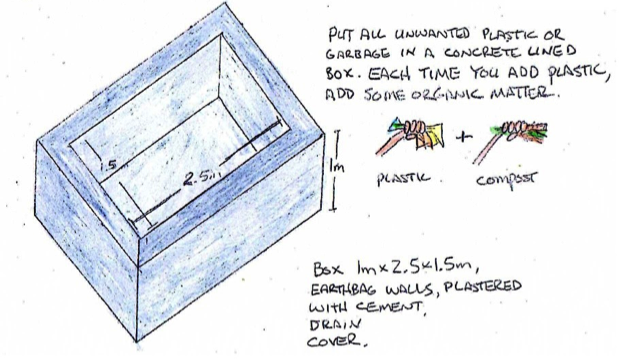
Build a 1.5m3 concrete container. Throw all of your waste, which should be mainly plastic after recycling what you can, into this container. As you add waste, add compost and fungi. Containing all of the waste in a concrete container will prevent toxins from seeping into the soil. You can either cover the box to seal the compost, or you can leave the box open to allow the sun to break down the plastic.
This idea would be more of a concept for research. The idea would be to see how much plastic you could decompose using simple techniques like sunlight and compost. Considering the alternatives like putting it to the curb and having someone else put it in a landfill (most likely) or burning it yourself, it’s worth a shot.
One strain of fungi called pestalotiopsis microspora, has been proven to polyurethane (plastic). This one particular strain, currently only found in the Amazon, can break down 5% of the plastic over the course of a year, as long as the plastic is first zapped with ultraviolet light.
Trash compacter
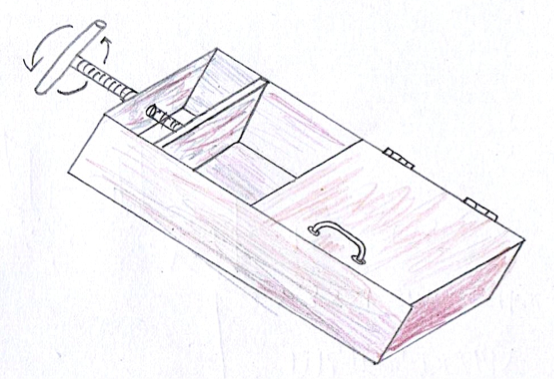
One way to get rid of trash is to compact it. You can make a trash compactor by just making a wooden box and then use a compacting arm to mash the trash into the size of a brick. Use wire to hold the brick together. You can reduce the trash volume by 50-90% depending on the type of trash your compacting. Here’s a good article about compressed garbage: http://www.motherearthnews.com/green-homes/recycled-plastic-block-houses.aspx#axzz3791jtKqi.
Trash compactor
Incinerator
Burning trash emits toxins into the air. But many people do it. One way to avoid inhaling the toxins, if you do choose to burn trash, is to make a burn ring away from where people hang out at your site. Put all unwanted, flammable, trash into a 200L metal drum and burn it. It is not the most ecological friendly solution, but it is one way to rid yourself of the trash. There is research to be done on small-scale garbage incinerators.
Waste-to-Energy
Waste-to-Energy (“WTE”) is a system designed to completely eliminate trash through incineration, energy recovery and recycling of the fly ash. The incinerator burns the trash and uses the heat from the fire to boil water, turn a steam engine and make electricity. Then the smoke and fly ash from the fire is collected and compacted into dense blocks, which can be used for construction. Look up Sysav (http://www.sysav.se/) to read about a Swedish WTE company who is consuming most of the garbage in Sweden.
Methane Collection Facility (Landfill)
Landfills are a great source of methane, a gas that seeps out of decomposing garbage. Methane electrical generators are deep holes bored into landfills, which can use the gas to turn turbines and make electricity. This works more on large-scale landfills. More research needs to be done on a small scale to make this a viable solution.
Human waste
Ecological sanitation (EcoSan) is an integrated sanitation strategy developed through traditional knowledge and biological science in which natural processes are utilized to transform human wastes into fertile soil. EcoSan provides an innovative, low-cost solution to human waste problems and improves a community’s general sanitation.
What are human feces made of?
These are some rough percentages of the composition of our poo and pee. While the actual percentages will vary greatly, these are listed mainly to illustrate the beneficial elements of our waste (Percentages from Natural Farming, by Dr Arnat Tancho):
- Organic matter (88-97%)
- Nitrogen (5-7%)
- Phosphorus (3-5%)
- Carbon (4.4-5.5%)
- Calcium (4.5%)
What is human urine made of?
- Organic matter (65-85%)
- Nitrogen (15-19%)
- Phosphorus (2.5-5%)
- Carbon (11.17%)
- Calcium (4.5-6%)
Human Waste and Hygiene Elements
Composting Toilets
Composting toilets are a way to dispose of human waste without water. There are many variations of composting toilets. A few are described below. The main components of composting toilets are that they don’t use water and they have a separate facility to decompose human waste. Here are a few composting toilet designs:
Humanure Toilet
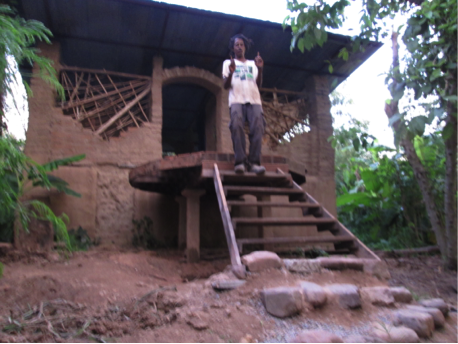
A Humanure toilet is a dry composting toilet for human poo. After you make a “deposit” in a Humanure toilet, you throw in a handful of sawdust, lime or some kind of drying agent. These additions allow for the poop to immediately begin decomposing.
Contrary to what you might think, Composting toilets do not smell. Once you add carbon, like sawdust, the moisture is absorbed and it doesn’t smell. Sometimes if you add too much urine, the chamber can smell. So it’s good to also install a Urine Diversion (below) to divert some of the urine away from the poo chamber.
After a poo chamber has filled up, one safe estimation is to wait six months. In that time, the pathogenic bacteria will die off and the Humanure can be used in your garden or forest.
Sizing the chamber
There is no real practical limit on the size of this kind of toilet. At the Panya Project, we built a Humanure toilet with space for four separate toilets as using adobe bricks and a concrete panel floor. Using cement or similar unnatural material for the floor is recommended so the moisture from the chamber doesn’t erode the floor.
The composting chambers in the toilets pictured above are 3m x 2m x 2m, totaling 12m3. One year after the toilet was opened, the chambers from the two operational stalls were still not full. A 12m3 chamber may be too large. 4m3 may be a more reasonable size. More research is underway.
One common design of a “Humanure” toilet, by Joseph Jenkins author of The Humanure Handbook, is to place a 20L bucket underneath a composting toilet. Variations of this design would include a larger container to be placed under the toilet. Another design option is to add a flue to the poo chamber. This will allow moisture to escape and help the pile break down faster.
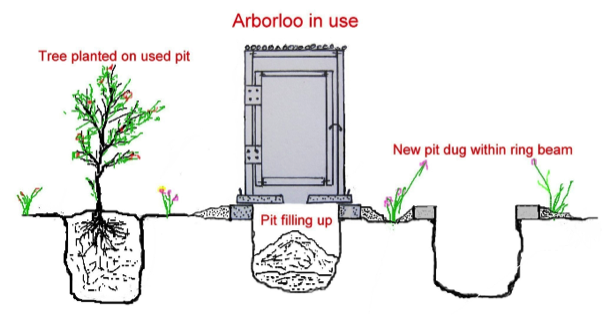
Arborloo
An arborloo is a movable composting toilet. First, dig a hole about 1m3 deep. Then set a lightweight, movable frame on top of the hole and build lightweight walls for privacy. Make your poo deposits. Once the hole fills up, move the frame to a new hole, mix the feces with soil and plant a tree on top. As human waste decomposes and becomes less toxic over time, it will provide good nutrients for the tree. Arborloo’s require no moving of human waste, just mixing it in the hole.
Solar Composting Toilet
You can also install a solar collector to the side of the poo chamber. The collector will capture heat during the day and channel it to the poo pit, this will also help speed up the process of decomposition.
Urine Diversion (UD) Toilet
Urine and water do slow the decomposition time down in a dry composting toilet. A urine diversion-composting toilet diverts urine into a separate hole or container. You can dilute urine with water, at a 1:10 ratio, and use on plants. You can also add wood vinegar to get rid of maggots and improve the smell of the poo chambers.
Human Waste Composting Pile
A human waste composting pile is a remote compost pile to decompose feces into fertilizer. The process calls for two waste areas. Line the bottom of both bins with a layer of plastic and a few inches of soil. The first bin should be mixed with sawdust, lime and any other drying agents you can get your hands on. Turn the pile at least once a week. Once the pile has aged for a few months, the feces loses its toxicity and can be transferred to the second pile. The second pile is to be inoculated with good soil from where it will likely be used. This pile should also be turned at least once a week. After a few more months, the soil is good, healthy fertilizer. Total composting time: about six months. Note: This area should be separate from your organic compost pile.
Flush Toilets
Flush toilets use a lot of water, about 4-20 liters per flush. Usually flush toilets are connected to a septic tank and a drainfield. This system can work well if the water is recycled into a garden, and you have access to enough water to continuously operate a flush toilet.
Bio-digester/Bio-gas system
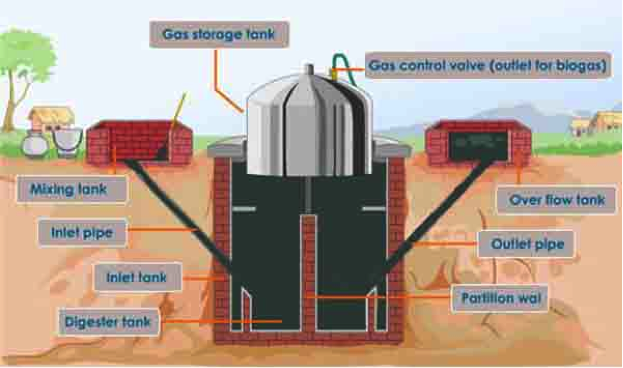
A bio-digester is large plastic sack for human and animal feces. The system has an input tube for feces and two outputs. One output directs methane gas to a cook stove. The other output directs feces to a container to hold bio-slurry. There are several types of bio-digesters. Here is a one found on Appropedia: http://www.appropedia.org/HSU_Chiapas_biodigester.
Bio-digestor detail – www.thebiooasis.com/biodigester
Septic Tank
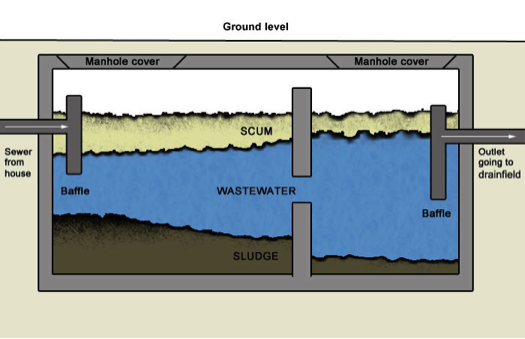
A septic tank is connected to the drainpipe of a flush toilet. Septic tanks are commonly designed with two chambers. In the first chamber, most of the waste solids sink to the bottom. When the first tank fills up, water spills into the second tank. The second tank provides a second area for solids to sink. When the second tank fills up, the overflow water runs out of the tank into a drainfield. Septic tanks need to be emptied when they fill up, so be sure to install a way to remove the solid waste. Look online for schematics and calculations.
Drainfield
A drain field is a place for septic tank runoff, as well as grey water (shower/laundry/kitchen drain) runoff. A drain field consists of connected perforated PVC pipes sloping at a slight downward angle. Long trenches need to be dug, lined with plastic then filled halfway with gravel. Lay perforated PVC pipe midway up the trench then fill the rest of the trench with gravel. Then plant non-edible plants above the gravel. As black and grey water trickle through the perforated PVC pipe, the water will be used to grow non-edible plants. Here are some instructions on how to build a drainfield: http://www.ehow.com/how_5039124_build-septic-drain-field.html.